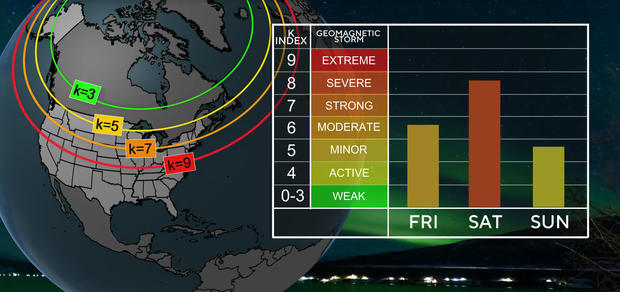
Rare severe geomagnetic storm watch issued for first time in nearly 20 years amid “unusual” solar event
A severe G4 geomagnetic storm could emerge on Friday, triggering a watch for a storm of this magnitude from NOAA officials for the first time in nearly 20 years. The watch comes after days of solar activity that seemingly sent several explosions of plasma and magnetic fields toward Earth.
G4s are the second-strongest form of geomagnetic storms and are known to potentially cause widespread voltage control problems. According to NOAA, they can also cause some protective systems to “trip out key assets from the grid,” as well as orientation issues for spacecraft. Aurora borealis, otherwise known as the northern lights, could be seen as far south as Alabama and in northern California as well.
NEXT Weather/CBS Boston
“If geomagnetic storms were hurricanes, ‘severe’ would be category 4,” SpaceWeather.com says.
press release on Thursday, NOAA said the most recent series of solar events started on May 8, when a large cluster of sunspots produced “several moderate to strong solar flares.” Solar flares are bursts of radiation known to be the solar system’s largest explosive events, according to NASA. The area where the recent flares occurred is 16 times the diameter of Earth, NOAA said, and more solar activity is expected.
That sunspot is so big you may be able to see it with your own eyes – with your solar eclipse glasses. The spot is known as AR3664. According to Space.com, it measures about 124,000 miles across and is one of the “largest and most active sunspots seen this solar cycle.”
There has also been a series of coronal mass ejections (CMEs), which are explosions of plasma and magnetic fields that come out of the sun’s corona, the outermost part of the sun’s atmosphere. At least five CMEs appear directed toward Earth and could arrive as early as midday on Friday and persist through Sunday, the agency said.
“This is an unusual event,” NOAA said.
In a call with reporters on Friday, Shawn Dahl, service coordinator at the Space Weather Prediction Center, said that some CMEs “are catching up with other ones.” He said officials are expecting a “big shock arrival” when they hit Earth. Dahl said while officials aren’t predicting a G5 storm – the strongest of geomagnetic storms – they also can’t discount a “low-end G5 event.”
“We’re really buckling down here,” Brent Gordon, chief of the space weather services branch, also said on the call.
NOAA
G4 conditions were detected by Friday afternoon, marking a “major disturbance in Earth’s magnetic field,” NOAA said, adding that “the public should stay properly informed of storm progression.”
In a forecast discussion at 12:30 p.m. on Friday, NOAA’s Space Weather Prediction Center said that solar activity is expected to continue at “high to very high levels” through the weekend, with additional solar flares expected, including X-class flares, the most powerful class of solar flares.
As of Friday afternoon, NOAA has observed a moderate solar radiation storm that could expose people in high-flying aircraft to “elevated radiation risk” and cause infrequent issues with satellite operations.
Radio blackouts have also been detected with an R3 designation, meaning that the blackouts were “strong” on a scale from R1 (minor) to R5 (extreme). At this level, wide blackouts of HF radio communication is expected, as well as loss of radio contact, for about an hour on the sunlit side of Earth, as low-frequency navigation signals decline for roughly an hour.
“Geomagnetic storms can impact infrastructure in near-Earth orbit and on Earth’s surface, potentially disrupting communications, the electric power grid, navigation, radio and satellite operations,” NOAA said. “[The Space Weather Prediction Center] has notified the operators of these systems so they can take protective action.”
Dahl agreed Friday that the event is “pretty extraordinary” and said that it could impact infrastructure, including high-voltage transmission lines of the power grid. Dahl said that infrastructure operators have been notified to adequately prepare.
The true strength of the storm won’t be known until roughly 8 p.m. ET on Friday when the CMEs are about a million miles from Earth.
“When we see those arrive, that’s when we’ll know the intensity,” Dahl said.
This is the first time a storm watch has been issued for a G4 since January 2005. There is an average of 100 severe geomagnetic storms every solar cycle, but so far, there have only been three observed in the most recent cycle that began in December 2019. The most recent occurred on March 23. The last time there was a G5 or extreme geomagnetic storm was in October 2003, when it caused power outages in Sweden and damaged transformers in South Africa.
More
More
Source: cbsnews.com

